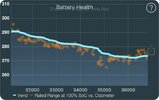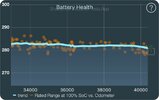So, knowing all of this, here's what I did:
1. I made it a habit to make sure that the BMS got to take OCV readings whenever possible. I turned off Sentry mode at work so that OCV readings could be taken there. I made sure that TeslaFi was set to allow the car to sleep, because if it isn't asleep, OCV readings can't get taken.
2. I quit charging every day. Round-trip to work and back for me is about 20% of the battery's capacity, and I used to normally charge to 90%. I changed my standard charge to 80%, and then I began charging the car at night only every 3 days. So day 1 gets OCV readings at 80% (after the charge is complete), day 2 at about 60% (after 1 work trip), and day 3 at about 40% (2 work trips). I arrive back home from work with about 20% charge on that last day, and if the next day isn't Saturday, then I charge. If the next day is Saturday (I normally don't go anywhere far on Saturday), then I delay the charge for a 4th day, allowing the BMS to get OCV readings at 20%. So now my BMS is getting data from various states of charge throughout the range of the battery.
3. I periodically (once a month or so) charge to 95%, then let the car sleep for 6 hours, getting OCV readings at 95%. Don't do this at 100%, as it's not good for the battery to sit with 100% charge.
4. If I'm going to take a long drive i.e. road trip, then I charge to 100% to balance the battery, then drive. I also try to time it so that I get back home with around 10% charge, and if I can do that, then I don't charge at that time. Instead, let the car sleep 6 hours so it gets OCV readings at 10%.
These steps allowed the BMS to get many OCV readings that span the entire state of charge of the battery. This gets it good data to run an accurate calibration computation.
So what's the results?
On 1/20/2020 at 30,700 miles, I was down to 270 miles full range, which is 40.8 miles lost (15.1 %). The first good, accurate recalibration occurred 4/16/2020 at 35,600 miles and brought the full range up to 286 miles. Then another one occurred on 8/23/2020 at 41,400 miles and brought the range up to 290 miles, now only a 20 mile loss (6.9 %).
Note that to get just two accurate calibration computations by the BMS took 7 months and 11,000 miles.
So, to summarize:
1. This issue is primarily an indication/estimation problem, not real battery capacity loss.
2. Constant Sentry mode use contributes to this problem, because the car never sleeps, so no OCV readings get taken.
3. Long voltage stabilization times in the Model 3 prevent OCV readings from getting taken frequently, contributing to BMS estimation drift.
4. Constantly charging every day means that those OCV readings that do get taken are always at the same charge level, which makes the BMS calibration inaccurate.
5. Multiple accurate calibration cycles may need to happen before the BMS accuracy improves.
6. It takes a long time (a lot of OCV readings) to cause the BMS to run a calibration computation, and therefore the procedure can take months.
I would love if someone else can perform this procedure and confirm that it works for you, especially if your Model 3 is one that has a lot of apparent degradation. It will take months, but I think we can prove that this procedure will work.






